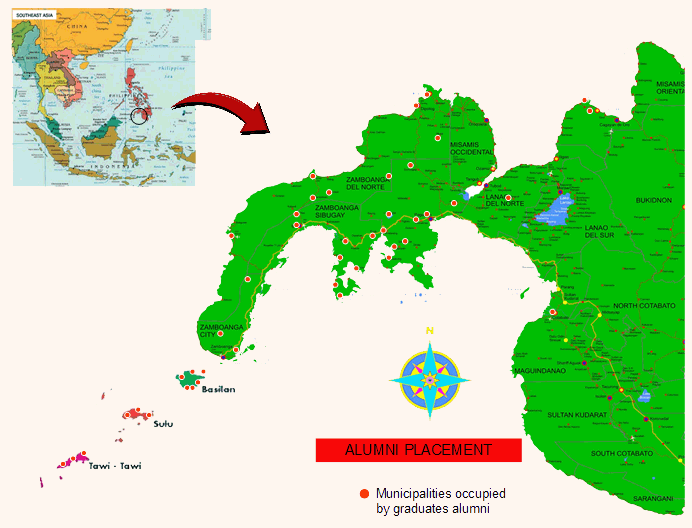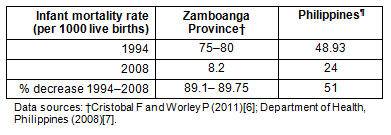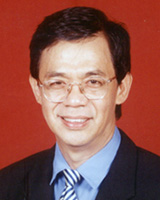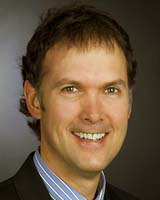As countries around the world struggle to scale-up their medical education infrastructure to meet an increasingly obvious medical workforce shortage and mal-distribution1-4, it is useful to examine successful models of workforce responsive medical schools.
In the early 1990s, a group of rural doctors in Zamboanga, Philippines, were frustrated by the continuing lack of doctors in their region and the resultant poor health outcomes of people living in their communities. They decided that one way to address this situation was to start their own medical school. This article describes the innovative approach used by these rural doctors and the changes in workforce and health outcomes that have occurred since the school's inception.
What this study adds
Medical schools are increasingly attempting to be more accountable to the communities they are funded to serve. However, there is little evidence of their impact on health outcomes in these communities. This study is the first report of an association between the formation of an innovative medical school in a low resource developing world setting and a significant improvement in both medical workforce and infant mortality.
A retrospective case study approach was used to describe the intervention and analyse the relevant health outcomes.
Context
The Zamboanga Peninsula is the south-western tip of the southernmost island in the Philippines archipelago, Mindanao. Forestry, mining and fishing are the main industries. There are approximately 1000 islands and islets in this predominately rural region where 3.2 million people over 17 000 km2 are served by 5 cities. Zamboanga City, the largest city in this region, is the centre for regional health services.
In 1994, 80% (mostly rural) of the 100 municipalities in the region lacked a doctor. There were 28 medical schools in the Philippines in 1994. Over 68% of their graduates practiced overseas5. The nearest of the 3 existing medical schools in Mindanao was 400 km away, approximately 11 hours' drive on difficult roads.
The region had one of the highest birth rates and infant mortality rates in the country and had a high incidence of malnutrition and infectious diseases including neonatal tetanus, measles, malaria, typhoid, schistosomiasis, cholera, tuberculosis, rabies, leprosy, malaria, and dengue fever.
Few physicians were willing to move to this underdeveloped area because of civil unrest arising from continual armed conflict among 'rebel' groups (Muslim secessionist groups) and government forces, and this contributed to further poor health in the population. There was limited access to potable water and proper sanitary facilities, limited health facilities, few health workers, difficulty accessing medicines and medical supplies, and significant logistic challenges in organizing healthcare delivery.
The intervention: creation of a new medical school
In 1993, seven concerned physicians, five community civic leaders and three educators convened and established the Zamboanga Medical School Foundation (ZMSF) with an initial working capital of US$500. After 10 years, this foundation incorporated into the Ateneo de Zamboanga University, becoming known as the Ateneo de Zamboanga University School of Medicine (ADZU SOM).
Local clinicians from the region who were undertaking postgraduate specialist training overseas deliberately sought out people with medical education expertise. In particular, Dr John F Smith from New Zealand, Dr Clarence Guenter and Dr Dale Guenter from Canada, and Dr Charles Engel from the UK provided significant guidance without cost. Also at no cost, the University of Calgary provided access to its Problem Based Learning (PBL) curriculum, and continued to support the initiative through faculty exchanges for the first 4 years.
The School opened in 1994 with a mission to help provide solutions to the health problems of the people and communities of Western Mindanao. There were 26 students in the first cohort. It was built on, and has been sustained over 15 years by, a spirit of volunteerism. The Ateneo de Zamboanga University (ADZU) contributed rooms at its campus without fee. Doctors from the region developed and taught the curriculum without any salary except for a gratis fee of US$20/month. The School has only three direct employees (secretary, librarian, research assistant), and the academic faculty consists of local health service employees and private practitioners. The Dean is employed by the health service.
Local civic leaders raised funds and sought assistance from international philanthropic agencies to keep student fees at an affordable level. Students were recruited from the local region through a combination of undergraduate grade point average, Otis Lennon School Mental Ability Test results, and an interview.
The curriculum: The curriculum incorporates small group PBL and community based learning from the first year. Problem based learning cases are based on regional and national priority health problems. These priority problems are grouped according to organ systems. After first tackling the problem in a PBL case, students then visit government hospitals where a real patient with similar problems is seen. Here they learn the bedside competencies of physical examination and communication skills.
Problem based learning and case-based learning occurs for 4 months per semester for the first 2.5 years. The fifth month of each semester is spent living with people in a variety of small communities where the student's knowledge base of individual health care is expanded into population health care. In the second semester of the third year students commence continuous clinical attachments in hospitals, including 24 hour duty every third day.
For the entire fourth year, the students live in the community, implementing the full community program they commenced developing in the first year. This community program includes community development focused on health issues and direct healthcare provision supervised by the local community leaders/health volunteers, locally based community doctors, University faculty, and alumni graduates working in the area. In the final-year students return to regional hospitals to integrate their clinical practice, after learning basic medical and public health skills in small communities throughout the region.
Cadaveric anatomy dissection was not included in the curriculum because using cadavers for study is regarded as desecration of the dead in this region. Instead, students use anatomic models, surface anatomy demonstrations with real patients, and diagnostic imaging to learn this component of the curriculum. When asked to comment on this, one of the clinicians noted: 'At Zamboanga, we care more about the living than the dead!' Both curriculum and assessment were driven by a competency outcome approach, rather than by reference to a traditional input-oriented model.
A 2011 review of School and student reports revealed the following outcomes. Between 15 and 35 students have been admitted to the School each year. The 164 graduates had a cumulative 90% pass rate at national licensing examinations. Over 90% of the graduates were still practicing in the Philippines, compared with the national average of 32%. Of these 90%, 85% were practicing in the Zamboanga region, with 50% in rural and remote areas. There continued to be a minimal in-flow of graduates from other medical schools to this region, despite national programs such as the 'Doctors to the Barios'. The location of graduates is shown (Fig1), and only 69% of municipalities were without medical care, compared with 80% in 1994.

Figure 1: Location of graduates of Ateneo de Zamboanga University School of Medicine.
Student initiated research and development projects in the communities have had significant impact. This included building pit latrines in the 80% of the region without this basic amenity, improving access to potable water, increased immunization rates, determining risk factors for TB DOTS (directly observed therapy - short course) default, developing cottage industry income generation, and the creation of home vegetable gardens. These initiatives of the medical school have mobilized significant latent community resources to ensure sustainability of the projects.
Student research has also had an impact on policy. The recommendations from one student research project on solid waste management were adopted into a Baranguy Ordinance and subsequently adopted by the entire Dapitan City. Likewise, a no-smoking policy has been adopted at the ADZU campus as the result of a student project.
Community interaction with the medical school has resulted in improved health knowledge and behaviours among local health workers, mothers, traditional healers and primary caregivers, leading to a better referral system from the remote areas. It has also mobilized health volunteers in the local community.
In the period 1994-2008, the infant mortality rate decreased by approximately 90% in Zamboanga, compared with a 50% national drop (Table 1). While further research is necessary to be able to assert causality in this association, that many of the other impacts mentioned above are significant social and medical determinants of this important health indicator lends weight to at least some credit being attributable to the creation and work of this innovative medical school.
Table 1: Change in infant mortality over the life of the
Ateneo de Zamboanga University School of Medicine6,7

Discussion
The ADZU SOM appears to be fulfilling its mission to help provide solutions to the health problems of the people and communities of Western Mindanao. By recruiting locally into a community-based curriculum developed and delivered with clear ownership by local clinicians and community leaders, it has produced a medical workforce that has chosen to live and work in this underserved region.
The ADZU is a founding member of the Training for Health Equity Network (THEnet)8, a global network of medical schools committed to socially accountable medical education as described by Boelen et al in 19959:
Social accountability is the obligation to orient education, research and service activities towards priority health concerns of the communities and the regions [that] schools have a mandate to serve. These priorities are jointly defined by government, health service organizations and the public.Zamboanga is an example of the outcomes and systems based approach advocated by THEnet that has resonance with many advocating reform of medical education and health services globally10-12.
The experience in Zamboanga describes a very cost-effective model of producing rural doctors who work in under-served communities. Rurally based teaching in the developed world has conventionally required large government investment. The ADZU experience of a sustained volunteer-based faculty suggests that further research may clarify the cultural, leadership and values-based factors that have maintained this motivation and commitment.
There is clear evidence from the developed world that merely increasing the number of doctors does not necessarily improve health outcomes13. This study supports the findings of other studies that suggest the skill set and motivation of graduates are the keys to future career choices that support health outcomes for communities, and that such motivation is influenced by preferential local student selection14,15, community based medical educational approaches16, and altruistic faculty role modeling17,18.
Attributing health and workforce outcomes to medical school interventions is notoriously difficult due to the required complex adaptive systems perspective19,20. THEnet is developing a systems-based evaluation framework which will prove helpful in understanding the contribution that ADZU has made to its communities8.
As countries struggle to find solutions to their health workforce and health outcome disparities, the example of the volunteers at Zamboanga may provide a way forward for even the poorest of regions, so that disadvantage does not have to be destiny.
These results can encourage governments and communities around the world to consider adopting a socially accountable approach to medical education as a cost-effective strategy to improve medical workforce in underserved areas.
References
1. Joyce C, McNeil J, Stoelwinder J. More doctors, but not enough: Australian medical workforce supply 2001-2012. Medical Journal of Australia 2006; 184(9): 441-446.
2. Worley P, Esterman A, Prideaux D. A cohort study of the examination performance of undergraduate medical students learning in community settings BMJ 2004; 328: 207-209.
3. Bowman RC. They really do go. Rural and Remote Health 8: 1035. (Online) 2008. Available: www.rrh.org.au (Accessed 12 July 2010).
4. Strasser RP, Lanphear JH, McReady WG, Topps MH, Hunt DD, Matte MC. Canada's new medical school: the Northern Ontario School of Medicine: social accountability through distributed community engaged learning. Academic Medicine 2009; 84(10): 1459-1464.
5. Mejia A, Pizurki H, Royston E. Physician and nurse migration. Geneva: World Health Organisation, 1979.
6. Fortunato C, Worley P. Transforming health professional's education. The Lancet 2011; 377(9773): 1235-1236.
7. Department of Health, Philippines. Annual Report. Manila: Department of Health, Philippines, 2008.
8. Pálsdóttir B, Neusy A, Reed G. Building the evidence base: networking innovative socially accountable medical education programs. Education for Health 8: 177. (Online) 2008. Available: http://www.educationforhealth.net (Accessed 12 July 2010).
9. 9. Boelen C, Heck J. Defining and measuring the social accountability of medical schools. Geneva: World Health Organization,1995.
10. Cooke M, Irby DM, O'Brian BC. A summary of educating physicians: a call for reform of medical school and residency. Stanford, CA: The Carnegie Foundation for the Advancement of Teaching, 2010.
11. de Savigny D, Adams T (Eds). Systems thinking for health systems strengthening. Geneva: Alliance for Health Policy and Systems Research, World Health Organization, 2009.
12. Strasser R, Neusy A-J. Context counts: training health workers in and for rural and remote areas. Bulletin of World Health Organization 2010; 88: 777-782.
13. Starfield B, Shi L, Grover A, Macinko J. The effects of specialist supply on populations' health: assessing the evidence. Health Affairs 24. (Online) 2005. Available: http://content.healthaffairs.org/cgi/content/full/hlthaff.w5.97/DC1 (Accessed 12 July 2010).
14. Dunbabin J, Levitt L. Rural origin and rural medical exposure: their impact on the rural and remote medical workforce in Australia . Rural and Remote Health 3: 212. (Online) 2003. Available: www.rrh.org.au (Accessed 12 July 2010).
15. Martini CJM, Veloski JJ, Barzansky B, Xu G, Fields SK. Medical school and student characteristics that influence choosing a generalist career. JAMA 1994; 272(9): 661-668.
16. Worley P, Martin A, Prideaux D, Woodman R, Worley E, Lowe M. Vocational career paths of graduate entry medical students at Flinders University: a comparison of rural, remote and tertiary tracks. Medical Journal of Australia 2008; 188(3): 177-178.
17. Coulehan J. Today's professionalism: engaging the mind but not the heart. Academic Medicine 2005; 80(10): 892-898.
18. Cruess SR, Cruess RL, Steinert Y. Role modeling: making the most of a powerful teaching strategy. BMJ 2008; 336: 718-721.
19. Boelen C, Woollard B. Social accountability and accreditation: a new frontier for educational institutions. Medical Education 2009; 43: 887-894.
20. Mennin S. Self-organisation, integration and curriculum in the complex world of medical education. Medical Education 2010; 44: 20-30.

